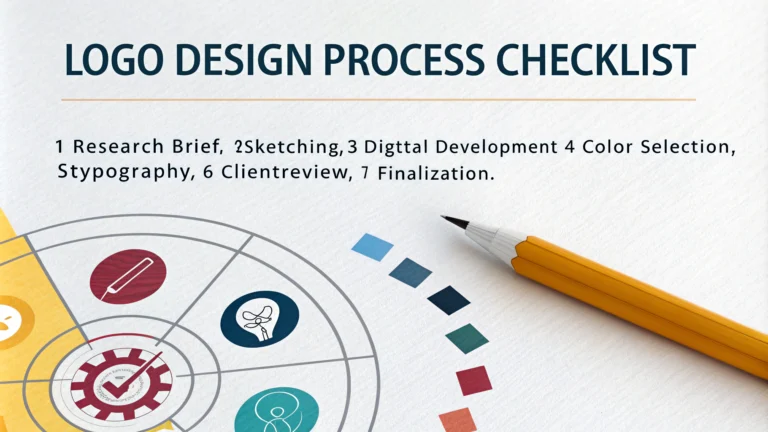A professional logo design process follows a structured approach to create memorable brand identities.
Project Brief & Research Phase
- Get detailed client requirements including target audience, industry, and brand values
- Research competitors’ logos and industry visual trends
- Create a mood board with inspiration and visual direction
- Define color preferences and restrictions
Sketching & Concept Development
- Start with quick pencil sketches – aim for at least 20-30 rough concepts
- Select 3-5 strongest concepts for further development
- Refine selected sketches with more detail
Digital Development
- Convert chosen sketches to vector format using Adobe Illustrator
- Experiment with different fonts and typography treatments
- Test various color combinations from the approved palette
- Create multiple variations of each concept
Technical Considerations
- Ensure logo works in black & white
- Test scalability from very small to very large sizes
- Check legibility across different mediums
- Create versions for different use cases (horizontal, vertical, icon only)
Client Presentation
- Present 2-3 strongest concepts with mock-ups
- Show real-world applications (business cards, signage, website)
- Provide rationale for each design decision
Refinement & Delivery
- Incorporate client feedback on selected concept
- Make final adjustments to colors, spacing, and proportions
- Prepare final files in multiple formats (AI, EPS, PDF, PNG, JPG)
- Create a simple brand guide with logo usage rules
Pro Tip: Always create logos in vector format first to ensure unlimited scalability.
Recommended Design Tools
- Adobe Illustrator – Industry standard for vector logo design
- Affinity Designer – Affordable alternative to Illustrator
- Figma – Excellent for collaboration and feedback
Common Pitfalls to Avoid
- Using too many colors or complex gradients
- Following trendy designs that may look dated quickly
- Creating designs that only work at certain sizes
- Using stock icons or clipart
For professional logo design services, contact the American Institute of Graphic Arts (AIGA) at www.aiga.org to find certified designers in your area.
Revisions & Iterations
- Plan for 2-3 rounds of revisions with client
- Document all feedback and change requests
- Maintain version control for different iterations
- Set clear boundaries for number of revision rounds
Logo Testing
- Conduct focus group testing if budget allows
- Test logo recognition and recall
- Verify cultural appropriateness across markets
- Check trademark availability
Brand Implementation
- Create comprehensive brand guidelines
- Develop templates for common applications
- Train client team on proper logo usage
- Provide support during initial rollout
Long-term Considerations
- Plan for future brand evolution
- Document design decisions and rationale
- Archive all working files securely
- Schedule periodic brand review sessions
Conclusion
A successful logo design process requires careful planning, creative exploration, and attention to technical details. By following these structured steps and considering both immediate and long-term requirements, designers can create lasting brand identities that serve their clients effectively. Remember that a great logo is not just about aesthetic appeal – it must function as a versatile business tool that communicates brand values clearly across all platforms and applications.
Note: Professional logo design is an investment in your brand’s future. Take time to find the right designer and follow a thorough process for the best results.
FAQs
- What are the essential steps in the logo design process?
The essential steps include research and discovery, sketching concepts, selecting color schemes, choosing appropriate typography, creating digital versions, refining designs, presenting to clients, gathering feedback, making revisions, and preparing final files in various formats. - How long should the logo design process typically take?
A professional logo design process typically takes 2-4 weeks, depending on project complexity, client feedback rounds, and revisions required. Rush jobs can be completed in 1 week, while more complex projects may take 6-8 weeks. - What file formats should be delivered in a final logo package?
Final logo packages should include AI (Adobe Illustrator), EPS, SVG, PDF, high-resolution PNG with transparent background, JPEG, and different color variations (full color, black, white, and reversed versions). - How many initial concept designs should be presented to a client?
Professional designers typically present 3-5 strong, distinct concepts to avoid overwhelming clients while providing enough variety for meaningful choice and discussion. - What makes a logo scalable and versatile?
A scalable and versatile logo uses vector graphics, maintains legibility at different sizes, works in both color and monochrome, and remains effective across various applications from business cards to billboards. - Should a logo design be trendy or timeless?
A logo should prioritize timelessness over trends to ensure longevity and avoid frequent redesigns. While it can incorporate contemporary elements, the core design should remain relevant for 5-10 years minimum. - What research should be done before starting the logo design process?
Research should include analyzing competitor logos, understanding industry standards, studying target audience preferences, reviewing client history and values, and examining successful logos in similar markets. - How many revisions should be included in a logo design package?
Professional logo design packages typically include 2-3 rounds of revisions after initial concept presentation. Additional revision rounds may incur extra charges. - What are the most common mistakes in logo design?
Common mistakes include using raster instead of vector graphics, incorporating too many elements or colors, following trends blindly, creating overly complex designs, and not considering scalability and various applications. - How should colors be chosen for a logo design?
Colors should be chosen based on color psychology, industry standards, target audience preferences, practical applications (print and digital), and brand personality. Typically, a logo should work effectively with 1-3 colors maximum.







